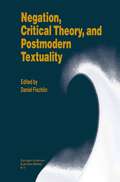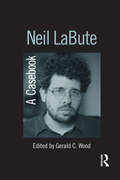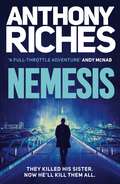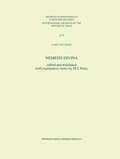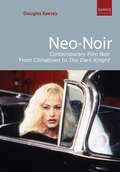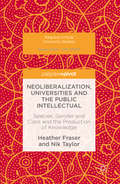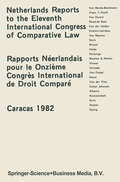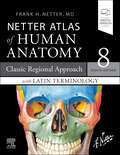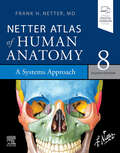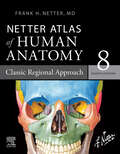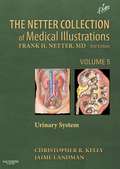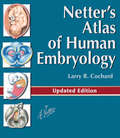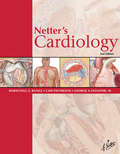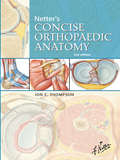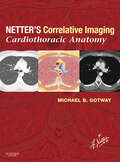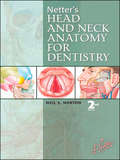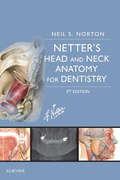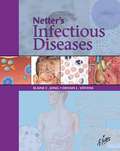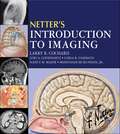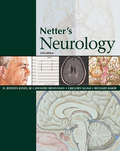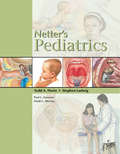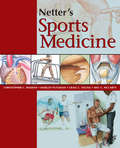- Table View
- List View
Negation, Critical Theory, and Postmodern Textuality
by Daniel FischlinNegation, Critical Theory, and Postmodern Textuality features 14 new essays by leading specialists in critical theory, comparative literature, philosophy, and English literature. The essays, which present wide-ranging historical considerations of negation in light of recent developments in poststructuralism and postmodernism, range over many of the siginificant texts in which negation figures prominently. The book includes a wide-ranging introductory chapter that examines how attention to negation -- the inescapable nescience that is posited in any and every linguistic expression -- enhances the hermeneutic possibilities present in language. In addition, the four sections of the book bring together major critical interventions on, among others, negative meaning, unrecognizability, elenctic negation, apocalypse, nihilism, negation and gender, and denegation. All the essays involve close attention to key texts by major authors, including William Shakespeare, Henry James, Federico García Lorca, Samuel Beckett, Thomas Bernhard, Walt Whitman, E.M. Forster, Mary Shelley, Margaret Atwood, Roland Barthes, Douglas Barbour, Paul de Man, bp Nichol, Jacques Derrida, and Dogen Kigen. The volume opens up new areas in critical theory, comparative literature, and the philosophy of language, and defines a major new area of inquiry in relation to notions of postmodern textuality. Critical theorists, students of comparative literature, English literature, and the history of ideas, and those interested in the hermeneutic implications of postmodernism will find this volume of substantial interest. Its extensive bibliographical apparatus and index make the collection a valuable reference tool for upper-level undergraduate and graduate students as well as for those seeking a variety of interpretive approaches to the problem of negation in literature.
Negotiated Justice and Corporate Crime
by Colin King Nicholas LordThis book argues that there is a strong normative argument for using the criminal law as a primary response to corporate crime. In practice, however, corporate crimes are rarely dealt with through criminal sanctioning mechanisms. Rather, the preference – for both prosecutors and corporates – appears to be on negotiating out of the criminal process. Reflecting this emphasis on negotiation, this book examines the use of Civil Recovery Orders and Deferred Prosecution Agreements as responses to corporate crime, and discusses a variety of UK case studies. Drawing upon legal and criminological backgrounds, and with an emphasis on the conceptual frameworks of ‘negotiated justice’ and ‘legitimacy’, the authors examine the law, policy and practice of these enforcement responses. They offer an original, theoretically-informed analysis which is accessible to practitioners and researchers.
Neil LaBute: A Casebook (Casebooks on Modern Dramatists)
by Gerald C. WoodNeil LaBute: A Casebook is the first book to examine one of the most successful and controversial contemporary American playwrights and filmmakers. While he is most famous, and in some cases infamous, for his early films In the Company of Men and Your Friends and Neighbors, Labute is equally accomplished as a playwright. His work extends from the critique of false religiosity in Bash to examinations of opportunism, irresponsible art, failed parenting, and racism in later plays like Mercy Seat, The Shape of Things, The Distance From Here, Fat Pig, Autobahn, and the very recent This Is How It Goes and Some Girls. Like David Mamet, an acknowledged influence on him, and Conor McPhereson, with whom he shares some stylistic and thematic concerns, LaBute tends to polarize audiences. The angry voices, violent situations, and irresponsible behavior in his works, especially those focusing on male characters, have alienated some viewers. But the writer's religious affiliation and refusal to condone the actions of his characters suggest he is neither exploitive nor pornographic. This casebook explores the primary issues of the writer's style, themes, and dramatic achievements. Contributors describe, for example, the influences (both classical and contemporary) on his work, his distinctive vision in theater and film, the role of religious belief in his work, and his satire. In addition to the critical introduction by Wood and the original essays by leading dramatic and literary scholars, the volume also includes a bibliography and a chronology of the playwright's life and works.
Neil LaBute: A Casebook (Casebooks on Modern Dramatists)
by Gerald C. WoodNeil LaBute: A Casebook is the first book to examine one of the most successful and controversial contemporary American playwrights and filmmakers. While he is most famous, and in some cases infamous, for his early films In the Company of Men and Your Friends and Neighbors, Labute is equally accomplished as a playwright. His work extends from the critique of false religiosity in Bash to examinations of opportunism, irresponsible art, failed parenting, and racism in later plays like Mercy Seat, The Shape of Things, The Distance From Here, Fat Pig, Autobahn, and the very recent This Is How It Goes and Some Girls. Like David Mamet, an acknowledged influence on him, and Conor McPhereson, with whom he shares some stylistic and thematic concerns, LaBute tends to polarize audiences. The angry voices, violent situations, and irresponsible behavior in his works, especially those focusing on male characters, have alienated some viewers. But the writer's religious affiliation and refusal to condone the actions of his characters suggest he is neither exploitive nor pornographic. This casebook explores the primary issues of the writer's style, themes, and dramatic achievements. Contributors describe, for example, the influences (both classical and contemporary) on his work, his distinctive vision in theater and film, the role of religious belief in his work, and his satire. In addition to the critical introduction by Wood and the original essays by leading dramatic and literary scholars, the volume also includes a bibliography and a chronology of the playwright's life and works.
Nemesis (The Protector)
by Anthony RichesMickey Bale, a Met close protection officer, wants revenge on the mafia family who killed his sister. First in The Protector, a gripping British thriller series from Anthony Riches. 'Nemesis is a full-throttle adventure' ANDY McNAB'Fast-moving... The Bill meets Jack Reacher' THE TIMES Thriller of the MonthThey killed his sister. Now he'll kill them all. Mickey Bale is an elite close protection officer. That's why the Met police has given him the toughest job of all: guarding the Minister of Defence at a moment when Chinese-British relations have hit a deadly boiling point.And when Mickey's life isn't on the line for his work, he's taking his chances waging war on a powerful London gang family. Their dealer supplied a lethal ecstasy pill to his sister, and Mickey is determined to take them down, one at a time.But will he get away with it – or will his colleagues in the force realise that the man on an underworld killing spree is one of their own?'Nemesis is a full-throttle adventure that twists and turns from the corridors of power to London's gangland underbelly, propelled by a hero with a thirst for vengeance and the skillset to execute it' Andy McNab'Nemesis kicks like a 12-bore shotgun... A British thriller to rival Reacher' Giles Kristian'Mickey Bale is a Jack Reacher for a harder, faster, more assured millennium. Nemesis is the kind of book for which the word 'compelling' was coined' Manda Scott'Meet Mickey Bale – London's John Wick. A rocket-propelled grenade of a book, shot through with gallows humour. Guy Ritchie meets Lee Child' Robyn Young'This may be Riches' first contemporary-set novel but he throws his protagonist into a gladiatorial climax worthy of Ancient Rome' Shots
Nemesis Divina (International Archives of the History of Ideas Archives internationales d'histoire des idées #177)
by Carl von LinnéLinnaeus' mature theodicy, his attempt to reconcile the suffering and evil of the world with the omnipotence and goodness of God, is presented in a condensed form in the final editions of his Systema Naturae (1758/68). In this comprehensive compendium of our knowledge of the three great realms of organic nature, he outlines the significance of the sub-conscious, social awareness and theological orientation in the spiritual life of man, and indicates how fate, fortune, and Providence interrelate within his conception of the Deity. In the Nemesis Divina this general undertaking is developed into an `experimental theology', which is exactly analogous to Linnaeus' work in the natural sciences, in that it involves the collecting and classifying of concrete and carefully described case-studies. He never prepared the manuscript for publication, however, and for many years it was regarded as lost, and it is only very recently that any attempt has been made to publish it in its entirety. This is the first English translation of all the relevant manuscript material. It is also the first attempt to analyse the case-studies in the light of what we know of Linnaeus' general taxonomic principles, and to relate each of them to its historical context.
Neo-Abolitionism: Abolishing Human Rentals in Favor of Workplace Democracy
by David EllermanThis book argues for the abolition of the employment system in favor of workplace democracy and thus escapes the usual capitalism-versus-socialism binary choice by reframing the basic issue as the employment contract, not private property or a market economy. The author repositions the political and economic debate in the lineage of abolitionism - against the owning of other people - which in its modern version of neo-abolitionism would also abolish the renting, or hiring, employing, or leasing of other people.The overall argument is based on three recovered theories, each one of which is sufficient to yield the neo-abolitionist conclusion. These three rights-based theories are developed throughout the book. The three theories are 1) inalienable rights theory, 2) the natural rights or labor theory of property, and 3) democratic theory as based on a democratic constitution that only delegates governance rights versus a non-democratic constitution that alienates governance rights. The book, therefore, is a must-read for everybody interested in a better understanding of the political economy, workplace democracy, rights-based theories, and the employment system.
Neo-Noir: Contemporary Noir Film From Chinatown To The Dark Knight
by Douglas KeeseyA world- weary detective, a seductive femme fatale, a mysterious murder- these elements of classic film noir live again in more recent hardboiled detective films from Chinatown to Sin City. But the themes and styles of noir have also spilled over into contemporary films about gangsters, cops and serial killers (Reservoir Dogs, The Departed, Se7en). New hybrid genres have been created, including psycho-noirs (Memento), techno-noirs (The Matrix) and superhero noirs (The Dark Knight). Beginning with an introduction that shows how neo-noir has drawn upon contemporary social and historical events as well as the latest technological advances in filmmaking, this book discusses the neo-noir films that have made the biggest splash in the field ('landmarks'), the directors who have become cult figures of neo-noir, ('auteurs'), films from non-English speaking countries ('international') and neo-noirs that put a new spin on past noirs ('remakes'). The main credits and a plot summary are given for each neo-noir, followed by an in-depth analysis containing original insights into the meaning of the film. 'Factoids' also present fascinating facts, behind-the-scenes anecdotes and lively quotes from the cast and crew.
Neoliberalization, Universities and the Public Intellectual: Species, Gender and Class and the Production of Knowledge (Palgrave Critical University Studies)
by Heather Fraser Nik TaylorThis book employs an an intersectional feminist approach to highlight how research and teaching agendas are being skewed by commercialized, corporatized and commodified values and assumptions implicit in the neoliberalization of the academy. The authors combine 50 years of academic experience and focus on species, gender and class as they document the hazardous consequences of seeing people as instruments and knowledge as a form of capital. Personal-political examples are provided to illustrate some of the challenges but also opportunities facing activist scholars trying to resist neoliberalism. Heartfelt, frank, and unashamedly emotional, the book is a rallying cry for academics to defend their role as public intellectuals, to work together with communities, including those most negatively affected by neoliberalism and the corportatization of knowledge.
Netherlands Reports to the XIth International Congress of Comparative Law Caracas 1982
by H. D'OliveiraLast year I addressed the Netherlands Comparative Law Asso ciation with the following question: 'Does Comparative Law Exist At All?' (My intention then was to flog the dead (?) horse of the merger of comparative law and the sociology of law. ) In presenting this voluminous collection of Netherlands national reports to the eleventh congress of the Internatio nal Academy of Comparative Law I feel my misgivings giving way to the suspicion, that comparative law indeed exists. Of course national reports do not, as such, prove the exist ence of comparative law. It is the general reports together with the national reports, which embody the comparative effort. That is why the Netherlands Comparative Law Associa tion took the initiative to propose the publishing of the materials on a subject to subject basis instead of publish ing collections of national reports. From a comparative legal point of view, it is the topic that should form the basis of the publication, and not the origin of the materials. The general reporter for each topic should be prepared to take up the responsabilities of editing the volume, and would have to be given the right to select those national reports which he considers to be useful both in regard to their quality and the relevance of the material to the basic problems in the questionnaire. This proposal met with very favourable comments from the na tional committees and general reporters of some fifteen coun tries.
Netter Atlas of Human Anatomy: Classic Regional Approach with Latin Terminology (Netter Basic Science)
by Frank H. NetterFor students and clinical professionals who are learning anatomy, participating in a dissection lab, sharing anatomy knowledge with patients, or refreshing their anatomy knowledge, the Netter Atlas of Human Anatomy illustrates the body, region by region, in clear, brilliant detail from a clinician’s perspective. Unique among anatomy atlases, it contains illustrations that emphasize anatomic relationships that are most important to the clinician in training and practice. Illustrated by clinicians, for clinicians, it contains more than 550 exquisite plates plus dozens of carefully selected radiologic images for common views. Presents world-renowned, superbly clear views of the human body from a clinical perspective, with paintings by Dr. Frank Netter as well as Dr. Carlos A. G. Machado, one of today’s foremost medical illustrators. Content guided by expert anatomists and educators: R. Shane Tubbs, Paul E. Neumann, Jennifer K. Brueckner-Collins, Martha Johnson Gdowski, Virginia T. Lyons, Peter J. Ward, Todd M. Hoagland, Brion Benninger, and an international Advisory Board. Offers region-by-region coverage, including muscle table appendices at the end of each section and quick reference notes on structures with high clinical significance in common clinical scenarios. Contains new illustrations by Dr. Machado including clinically important or difficult to understand areas such as the Cavitas pelvis, Fossa temporalis and Fossa infratemporalis, Conchae nasi, and more. Features new nerve tables devoted to the Nervi craniales, Plexus cervicalis, Plexus brachialis, and Plexus lumbosacralis. Uses updated terminology based on the international anatomic standard, Terminologia Anatomica, with common clinical eponyms included. Enhanced eBook version included with purchase. Your enhanced eBook allows you to access all of the text, figures, and references from the book on a variety of devices. Provides access to extensive digital content: every plate in the Atlas?and over 100 bonus plates including illustrations from previous editions?is enhanced with an interactive label quiz option. Also available: • Netter Atlas of Human Anatomy: Classic Regional Approach -With US English terminology. • Netter Atlas of Human Anatomy: A Systems Approach—With US English terminology. Same content as the classic regional approach, but organized by body system. All options contain the same table material and 550+ illustrated plates painted by clinician artists, Frank H. Netter, MD, and Carlos Machado, MD.
Netter Atlas of Human Anatomy: English And Latin Edition (Netter Basic Science)
by Frank H. NetterFor students and clinical professionals who are learning anatomy, participating in a dissection lab, sharing anatomy knowledge with patients, or refreshing their anatomy knowledge, the Netter Atlas of Human Anatomy illustrates the body, system by system, in clear, brilliant detail from a clinician’s perspective. Unique among anatomy atlases, it contains illustrations that emphasize anatomic relationships that are most important to the clinician in training and practice. Illustrated by clinicians, for clinicians, it contains more than 550 exquisite plates plus dozens of carefully selected radiologic images for common views. Presents world-renowned, superbly clear views of the human body from a clinical perspective, with paintings by Dr. Frank Netter as well as Dr. Carlos A. G. Machado, one of today’s foremost medical illustrators. Content guided by expert anatomists and educators: R. Shane Tubbs, Paul E. Neumann, Jennifer K. Brueckner-Collins, Martha Johnson Gdowski, Virginia T. Lyons, Peter J. Ward, Todd M. Hoagland, Brion Benninger, and an international Advisory Board. Offers coverage newly organized by organ system, including muscle table appendices and quick reference notes on structures with high clinical significance in common clinical scenarios. Contains new illustrations by Dr. Machado including clinically important areas such as the pelvic cavity, temporal and infratemporal fossae, nasal turbinates, and more. Features new nerve tables devoted to the cranial nerves and the nerves of the cervical, brachial, and lumbosacral plexuses. Uses updated terminology based on the international anatomic standard, Terminologia Anatomica, with common clinical eponyms included. Provides access to extensive digital content: every plate in the Atlas?and over 100 bonus plates including illustrations from previous editions?is enhanced with an interactive label quiz option and supplemented with "Plate Pearls" that provide quick key points and supplemental tools for learning, reviewing, and assessing your knowledge of the major themes of each plate. Tools include over 300 multiple choice questions, videos, 3D models, and links to related plates. Own your own personal copy of the world-famous Netter Atlas of Human Anatomy! This well-loved title, now in 8th edition, is available in multiple options. Choose the one best for you: • Netter Atlas of Human Anatomy: A Systems Approach—Described above • Netter Atlas of Human Anatomy: Classic Regional Approach—Same content as the systems approach, but organized by body region • Netter Atlas of Human Anatomy: Classic Regional Approach with Latin terminology All options contain the same table information and same 550+ illustrated plates painted by clinician artists, Frank H. Netter, MD, and Carlos Machado, MD.
Netter Atlas of Human Anatomy: English And Latin Edition (Netter Basic Science)
by Frank H. NetterFor students and clinical professionals who are learning anatomy, participating in a dissection lab, sharing anatomy knowledge with patients, or refreshing their anatomy knowledge, the Netter Atlas of Human Anatomy illustrates the body, region by region, in clear, brilliant detail from a clinician’s perspective. Unique among anatomy atlases, it contains illustrations that emphasize anatomic relationships that are most important to the clinician in training and practice. Illustrated by clinicians, for clinicians, it contains more than 550 exquisite plates plus dozens of carefully selected radiologic images for common views. Presents world-renowned, superbly clear views of the human body from a clinical perspective, with paintings by Dr. Frank Netter as well as Dr. Carlos A. G. Machado, one of today’s foremost medical illustrators. Content guided by expert anatomists and educators: R. Shane Tubbs, Paul E. Neumann, Jennifer K. Brueckner-Collins, Martha Johnson Gdowski, Virginia T. Lyons, Peter J. Ward, Todd M. Hoagland, Brion Benninger, and an international Advisory Board. Offers region-by-region coverage, including muscle table appendices at the end of each section and quick reference notes on structures with high clinical significance in common clinical scenarios. Contains new illustrations by Dr. Machado including clinically important areas such as the pelvic cavity, temporal and infratemporal fossae, nasal turbinates, and more. Features new nerve tables devoted to the cranial nerves and the nerves of the cervical, brachial, and lumbosacral plexuses. Uses updated terminology based on the second edition of the international anatomic standard, Terminologia Anatomica, and includes common clinically used eponyms. Provides access to extensive digital content: every plate in the Atlas?and over 100 bonus plates including illustrations from previous editions?is enhanced with an interactive label quiz option and supplemented with "Plate Pearls" that provide quick key points and supplemental tools for learning, reviewing, and assessing your knowledge of the major themes of each plate. Tools include over 300 multiple choice questions, videos, 3D models, and links to related plates. Own your own personal copy of the world-famous Netter Atlas of Human Anatomy! This well-loved title, now in 8th edition, is available in multiple options. Choose the one best for you: • Netter Atlas of Human Anatomy: Classic Regional Approach—described above • Netter Atlas of Human Anatomy: A Systems Approach—Same content as the classic regional approach, but organized by organ systems. • Netter Atlas of Human Anatomy: Classic Regional Approach with Latin terminology All options contain the same table information and same 550+ illustrated plates painted by clinician artists, Frank H. Netter, MD, and Carlos Machado, MD.
The Netter Collection of Medical Illustrations - Urinary System e-Book (Netter Green Book Collection #Volume 5)
by Christopher R Kelly Jaime LandmanThe Urinary System, 2nd Edition provides a concise and highly visual approach to the basic sciences and clinical pathology of the kidney, bladder, and ureters. This volume in The Netter Collection of Medical Illustrations (the CIBA "Green Books") has been expanded and revised by Drs. Christopher Rehbeck Kelly and Jaime Landman to capture current clinical perspectives in nephrology and urology - from normal anatomy, histology, physiology, and development to glomerular and tubular diseases, infections, urological surgeries, and cancers. It also features hundreds of radiologic and pathologic images to supplement the classic Netter illustrations, as well as new illustrations created Get complete, integrated visual guidance on the kidney, ureters, and bladder in a single source, from basic sciences and normal anatomy and function through pathologic conditions. Adeptly navigate current controversies and timely topics in clinical medicine with guidance from expert editors, authors, and the input of an international advisory board. Gain a rich, comprehensive clinical view of the urinary system by seeing classic Netter anatomic illustrations side by side with cutting-edge radiologic images, pathology slides, and the latest molecular biology findings. Visualize the timely topics in nephrology and urology, including HIV-associated nephropathy, hepatorenal syndrome, laparoscopic and robotic surgeries, and tumor cryoblation. See current clinical concepts captured in the visually rich Netter artistic tradition via contributions from Carlos Machado, MD, and other artists working in the Netter style.
Netter's Atlas of Human Embryology E-Book: Updated Edition (Netter Basic Science)
by Larry R. CochardHere's a rich pictorial review of normal and abnormal human prenatal development. For each body system or region, you'll find a brief description of the developmental plan, with key concepts and terminology, followed by discussions of histological principles, the classification of congenital defects, and basic cellular, molecular, and genetic concepts; An emphasis on morphological patterns in the embryo and fetus makes it easy to understand the structure and function of the adult body and the embryonic basis of birth defects. Summary tables and terminology sections at the end of each chapter, plus an appendix with all major congenital defects and their embryonic basis, make it easy to review course material and prepare for the USMLE.
Netter's Cardiology E-Book (Netter Clinical Science)
by George Stouffer Marschall S. Runge Cam PattersonNetter’s Cardiology, 2nd Edition, by Marschall S. Runge, Cam Patterson, and George Stouffer, uses visually rich Netter artwork to efficiently provide you with a concise overview of cardiovascular anatomy, pathophysiology, diagnosis, and management. You'll rapidly access complete introductions to common issues in cardiology, including annotated references of the most important articles, guidelines, and available evidence. Netter - it's how you know.Efficiently review key details of anatomy, pathophysiology, and clinical presentation with detailed, crystal-clear artwork by Frank H. Netter, MD and other illustrators working in the Netter tradition. Apply dependable clinical advice from Marschall S. Runge, MD, PhD, Cam Patterson, MD and George Stouffer, MD and utilize diagnostic and therapeutic algorithms and clinical pathways developed by the many world-renowned chapter contributors. Utilize annotated references to the most important resources and evidence-based studies. Benefit from expanded coverage of cardiovascular imaging including echocardiography, stress testing and nuclear imaging, and CT and MRI.
Netter's Concise Orthopaedic Anatomy E-Book (Netter Basic Science)
by Jon C. ThompsonNetter’s Concise Orthopaedic Anatomy is a best-selling, portable, full-color resource excellent to have on hand during your orthopaedic rotation, residency, or as a quick look-up in practice. Jon C. Thompson presents the latest data in thoroughly updated diagnostic and treatment algorithms for all conditions while preserving the popular at-a-glance table format from the previous edition. You’ll get even more art from the Netter Collection as well as new radiologic images that visually demonstrate the key clinical correlations and applications of anatomical imaging. For a fast, memorable review of orthopaedic anatomy, this is a must-have. Maintains the popular at-a-glance table format that makes finding essential information quick and convenient. Contains useful clinical information on disorders, trauma, history, physical exam, radiology, surgical approaches, and minor procedures in every chapter. Lists key information on bones, joints, muscles, and nerves in tables correlate to each Netter image. Highlights key material in different colors—pearls in green and warnings in red—for easy reference. Features both plain film and advanced radiographic (CT and MRI) images, along with cross-sectional anatomic plates for an even more thorough visual representation of the material. This "updated" second edition includes test-yourself images and notes. All other content is the same as the 2010 2nd edition.
Netter’s Correlative Imaging: With Online Access (Netter Clinical Science)
by Michael B. GotwayCardiothoracic Anatomy, the third title in the brand-new Netter’s Correlative Imaging series, provides exceptional visual guidance for thoracic, chest wall, lung, and heart anatomy. Dr. Michael Gotway presents Netter’s beautiful and instructive paintings and illustrated cross sections created in the Netter style side-by-side with high-quality patient images from breath-hold cardiac MR, multislice thoracic CT, and CT coronary angiography to help you visualize the anatomy section by section. With in-depth coverage and concise descriptive text for at-a-glance information and access to correlated images online, this atlas is a comprehensive reference that’s ideal for today’s busy imaging specialists.View thoracic, chest wall, lung, and heart anatomy in breath-hold cardiac MR, multislice thoracic CT, and CT coronary angiography, each image complemented by a detailed illustration in the instructional and aesthetic Netter style.Find anatomical landmarks quickly and easily through comprehensive labeling and concise text highlighting key points related to the illustration and image pairings.
Netter's Head and Neck Anatomy for Dentistry E-Book (Netter Basic Science)
by Neil S. NortonNetter’s Head and Neck Anatomy for Dentistry, by Neil S. Norton, PhD, uses more than 600 full-color images from the Netter Collection to richly depict all of the key anatomy that’s relevant to clinical practice. This new edition takes your knowledge further than ever with more Netter illustrations; addition of over 20 cone beam CT images; new chapters on the upper limbs, thorax, and abdomen; and more than 100 multiple-choice questions. Whether for your dental anatomy course, board review, or as a handy reference in your dental office, this concise, visual guide is an excellent anatomy atlas and quick reference for students and professionals in dentistry and dental hygiene.Identify clinically relevant anatomy with Netter illustrations highlighted and modified for dentistry. See the practical important of anatomy from illustrated clinical examples in each chapter. Review essential concepts easily with tables that display the maximum amount of information in an at-a-glance format. Master anatomy for the head and neck and beyond, including upper limbs, thorax, and abdomen. Stay current on hot topics like cone beam CT imaging, intraoral injections, and anesthesia. Recognize the context and clinical relevance of head and neck anatomy through additional coverage of dental procedures. Prepare effectively for the dental boards with over 100 multiple-choice questions.
Netter's Head and Neck Anatomy for Dentistry E-Book (Netter Basic Science)
by Neil S. NortonA concise and visual guide to clinically relevant anatomy for dentistry, Netter’s Head and Neck Anatomy for Dentistry is an effective text for class and exam preparation, as well as a quick review in professional practice. Concise text, high-yield tables, clinical correlations, and review questions combine to make this new edition a perfect choice for learning and remembering the need-to-know structures, relationships, and concepts, while beautiful illustrations created in the Netter tradition enhance your visual mastery of the material. You may also be interested in: A companion set of flash cards, Netter's Advanced Head & Neck Anatomy Flash Cards, 3rd Edition.Over 100 multiple-choice questions complete with explanations help you assess your knowledge of the material and prepare for exams.Identify clinically relevant anatomy with Netter illustrations and new art created in the Netter tradition.Concise text and high-yield tables offer fast access to important facts.Procedures coverage gives context and clinical meaning to the anatomy.Expanded, up-to-date coverage on dental implants, cone beam imaging, and mandible osteology.Beautiful new illustrations by Carlos Machado, MD, of the TMJ, articular disc pathology, infratemporal fossa, pterygopalatine fossa, and maxillary artery.
Netter's Infectious Diseases E-Book
by Elaine C. Jong Dennis L. StevensNetter’s Infectious Diseases provides a comprehensive yet concise overview of current global infectious disease concerns. Elaine Jong and Dennis Stevens cover the basics of the field using beautiful Netter illustrations and accessible "need to know" information on major conditions and problems— including multi-drug-resistance, Staph infections, Chagas disease, and the flu. In print and online, it’s a great tool for quick review or for sharing with patients and staff.Review the basics of infectious disease through comprehensive coverage contained in a single volume reference. Apply "need to know" information from the uniformly concise text and instructive Netter paintings. View detailed Netter illustrations that provide a quick and memorable overview of microbiology, pathophysiology, and clinical presentation. Stay current on modern infectious disease concerns—such as multi-drug-resistant tuberculosis, Staph aureus, Chagas disease, and the flu—with new illustrations in the Netter tradition specifically created to address new topics. Access a companion website at www.netterreference.com featuring the complete searchable text, an Image Bank containing all of the book’s illustrations…downloadable for your personal use, plus 25 printable patient education brochures.
Netter's Introduction to Imaging E-Book: With Student Consult Access (Netter Basic Science)
by Larry R. Cochard Lori A Goodhartz Carla Harmath Nancy M. Major Srinivasan Mukundan Jr.Netter’s Introduction to Imaging, by Larry R. Cochard, PhD, Lori A Goodhartz, MD Carla B, Harmath, MD, Nancy M. Major MD, and Srinivasan Mukundan, JR, MD, makes interpreting normal and abnormal X-ray, CT, and MR images easy by correlating them with crystal-clear Netter illustrations. You'll learn to recognize anatomical relationships in images and apply them to a variety of examples of pathology throughout the body, including the imaging of masses, air, or blood in organs and spaces...fractures, thickening, constriction, and compression...and more. It's an ideal introduction to diagnostic imaging! [This eBook does NOT come with pincode access to StudentConsult.com. All content is included within the ebook file. Only purchases of the printed version of this book include a pincode for online access.]Visualize anatomical structures and relationships with perfect clarity with the aid of vivid, colorful Netter artwork. The coloring, texture, and idealized emphasis help you interpret relationships between structures and compartments as seen in cross section and in X-rays, CT, and MRI. Develop your ability to better identify pathologies by viewing normal healthy anatomical images and abnormal images. Comparative images reinforce your basic understanding of what normal tissues and anatomy look like and serve as a guide in recognizing disease patterns and processes: atypically large or small organs and compartments, masses, air, or blood in organs and spaces, fractures, thickening, constriction, compression, and more. Understand the principles that underlie X-ray, CT, MR, ultrasound, and nuclear medicine imaging, the use of contrast and angiography. Understand how radiologists apply systematic search strategies in imaging studies of each region of the body.
Netter's Neurology E-Book (Netter Clinical Science)
by H. Royden Jones, Jr. Jr. Jayashri Srinivasan Gregory J. Allam Richard A. BakerNetter's Neurology, 2nd Edition, by Drs. H. Royden Jones, Jayashri Srinivasan, Gregory J. Allam, and Richard A. Baker, uses visually rich Netter artwork to efficiently provide you with a concise overview of general neurology and its intersection with internal medicine, neurosurgery, ophthalmology, psychiatry, and orthopedics. "It communicates often very difficult areas of neurology quite simply, and builds on basics to advanced understanding. I've never seen such well-thought-out and informative illustrations with such detail in another neurology book of this type." - First Prize Winner, Illustrated Book Category, British Medical Association 2012 Medical Book CompetitionMaster general neurology and its intersection with internal medicine, neurosurgery, ophthalmology, psychiatry, and orthopedics through comprehensive topic coverage. Get a quick and memorable overview of anatomy, pathophysiology, and clinical presentation from the precision and beauty of Netter and Netter-style plates that highlight key neuroanatomical and neurologic concepts. Explore specific clinical applications with vignettes included throughout the text that bring each topic to life. Find the information you need quickly and easily thanks to the short text and concise topic overviews. See the latest developments in the field in clear detail with new artwork and new entries on ALS, Eastern Equine Encephalitis, African Sleeping Sickness, and more. Effectively visualize the underlying anatomy in living patients through upgraded neuroimaging coverage, including MR, CT, and PET. Tap into additional treatment information with more clinical vignettes that provide "real-life" illustrative case evaluations.
Netter's Pediatrics E-Book (Netter Clinical Science)
by Todd Florin Stephen Ludwig, MD Paul L. Aronson Heidi C. WernerNetter’s Pediatrics, edited by Drs. Todd Florin and Stephen Ludwig, is a rich visual aid with more than 500 images by Dr. Frank Netter and other artists working in his style that will help you diagnose and care for children with common clinical conditions. This is the first time that Netter’s drawings of pediatric illness are brought together in a single volume. The superb, accurate artwork accompanies up-to-date text contributed by physicians at the prestigious Children’s Hospital of Philadelphia. The book provides you with all the at-a-glance information you need for a quick overview of common issues from nutrition, allergy, infectious disease, and adolescent medicine, to cancer and heart disease. This user-friendly, clinical reference is also a great tool for patient and staff education.Efficiently review key details for each condition with 500 detailed, crystal-clear images provided by Frank H. Netter and others working in the Netter tradition. Apply dependable, concise, clinical advice from a team of physicians at Children’s Hospital of Philadelphia, one of the top children’s hospitals in the U.S. Get answers at a glance during pediatric rotations when studying for exams or preparing for consultations.
Netter's Sports Medicine E-Book: Netter's Sports Medicine (Netter Clinical Science)
by Christopher Madden Margot Putukian Eric McCarty Craig YoungNetter’s Sports Medicine, by Christopher C. Madden, MD, Margot Putukian, MD, FACSM, Craig C. Young, MD, and Eric C. McCarty, MD, is a reference designed to help you meet the challenges presented by your patients in this growing interdisciplinary field. More than 1,000 Netter images, along with photos of physical examination techniques and imaging examples, provide a rich visual understanding, while a bulleted text format, combined with a user-friendly organization by specific types of injuries as well as different types of sports, makes reference quick and easy. Discussions of a full range of sports—traditional as well as less common—ensure that the coverage is comprehensive and up to date. From pre-participation exams, musculoskeletal injuries, sports nutrition, and sports psychology...to general medical problems in athletes...this reference equips you with the guidance you need to keep your patients at the top of their game.Presents more than 1,000 Netter illustrations accompanied by photos of physical examination techniques, radiographs, and other imaging techniques—including CT and MRI—that equip you with a rich visual understanding of sports medicine. Features a bulleted text format for quick-read guidance. Organizes information by specific types of injuries as well as different types of sports for an easy-to-access reference. Discusses traditional along with less common sports for comprehensive coverage that is up to date. Includes a section that examines considerations for specific athlete populations, including children, women, the senior athlete and the physically challenged, to help you meet their special needs. Presents the cross-disciplinary contributions of primary care physicians, athletic trainers, physical therapists, dentists, orthopaedic surgeons, and others, who provide a well-rounded perspective on the subject. Combines current, evidence-based information with expert clinical guidance for a high-yield reference.
